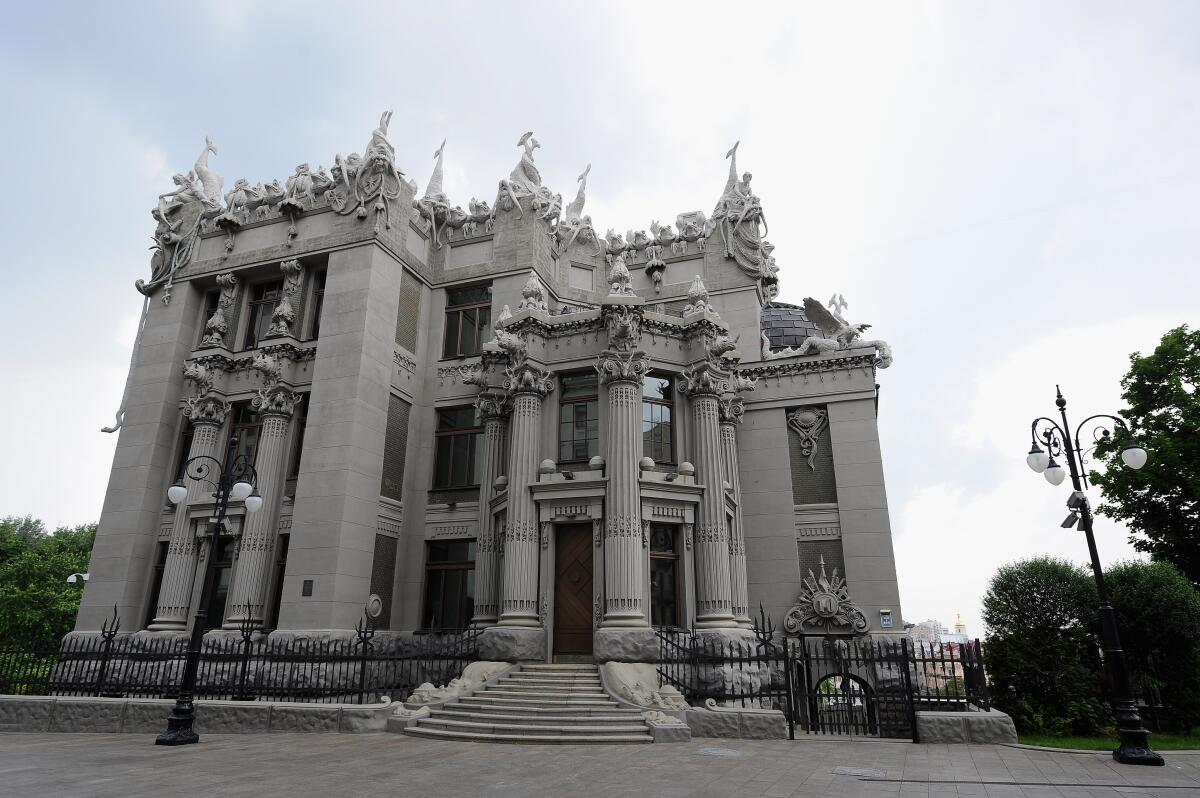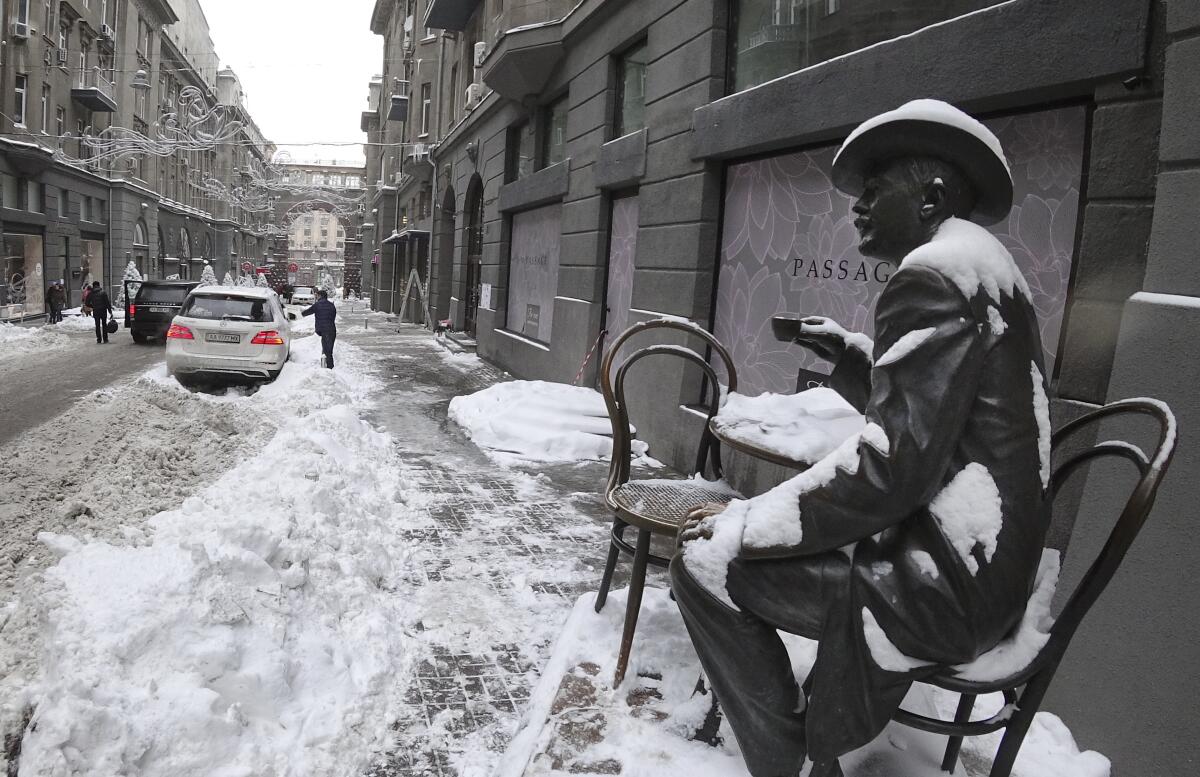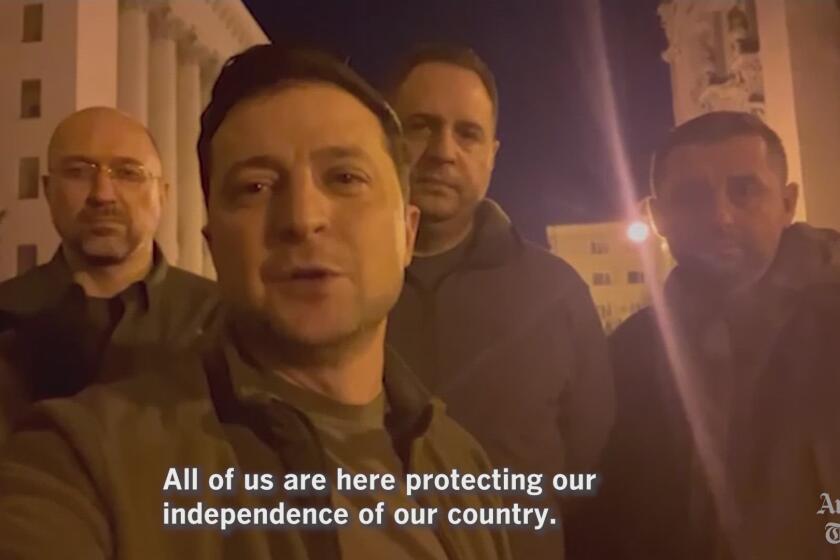Why it matters that Zelensky stood before a building by ‘the Gaudi of Ukraine’ on social media

- Share via
In 1903, an architect by the name of Vladislav Gorodetsky put the finishing touches on a luxurious apartment building in the center of the Ukrainian capital, Kyiv. To say that the building is unusual would be a vast understatement.
Gorodetsky — alternately known in English as Wladyslaw Horodecki — was a Polish-born architect dubbed “the Gaudi of Ukraine.” His namesake building fuses Beaux-Arts and Art Nouveau styles with a roofline and facade bearing a truly bizarre menagerie of grotesqueries: Rows of frogs patrol the roofline, an elephant bulges from the building’s skin, heads of deer and rhinoceros emerge from atop Corinthian columns. And, on the roof, mermaids ride writhing fish.
As arts writer and editor John Pancake once described Gorodetsky House in a 2010 Wall Street Journal dispatch: This was a structure created by “a man who hated the dull, the safe, the easy.”
It therefore could not be more apropos that the building has emerged as architectural backdrop to one of Ukrainian President Volodymyr Zelensky’s urgent social media dispatches. On Saturday, as Russian troops unleashed their attack on Ukraine, and rumors swirled that Zelensky might be evacuated from the country, the Ukrainian leader stood firmly before Gorodetsky House and declared: “I am here. We are not laying down our arms. We will defend our state.”
He could be nowhere else. Gorodetsky House exists only in Kyiv.
Like countless people around the world, I have been glued to my phone for news updates on the Russian invasion of Ukraine. And like countless others, I have been deeply moved by Zelensky’s eloquence, his fearlessness and his social media savviness amid Vladimir Putin’s senseless invasion.
It has been gripping for what is at stake: the sovereignty of Ukraine and the lives and deaths of millions. It has also been gripping for how Zelensky, an actor and comedian turned politician — whose inexperience was cause for great concern as tensions with Russia boiled — has not only led with great strength, but masterfully deployed the internet as a weapon.
In some of his videos, Zelensky appears decked out in stylish olive green raglan tees; in others, he serves as his own jittery camera operator. This gives him an air of a tough, youthful leader deep in the trenches. Putin, by contrast, has appeared in dark suits, giving statements from gilded rooms like “a detached and scowling villain in a John Le Carré novel,” as my colleagues Nabih Bulos and Kate Linthicum wrote in a recent analysis of how Zelensky is winning the public relations war.
Times fashion scribe Adam Tschorn told me via Slack, “Zelensky in a raglan-sleeve olive-green shirt beats a shirtless Putin any day.”
I get the feeling that raglan shirts — which have design roots in the Crimean War (the one from the 19th century) — will soon be making a comeback.
Ukrainian President Volodymyr Zelensky’s social media savvy has helped give Ukraine a fighting chance against the Kremlin’s massive army and disinformation juggernaut.
In employing the building as a symbolic backdrop, Zelensky also seemed to be pointing to the cultural heritage that is at stake.
As Artnet’s Sarah Cascone has reported, Ukraine’s museums have been scrambling in the face of the Russian advance, attempting to find secure storage for thousands of objects. On Monday, the Kyiv Independent, an English-language news outlet based in Ukraine, tweeted that Russian troops had burned down a museum of Ukrainian folk art in Ivankiv, a city northwest of the capital. Afterward, Ukraine’s minister of culture asked UNESCO to strip Russia of its membership in the organization — presumably for violating the Hague Convention for the Protection of Cultural Property in the Event of an Armed Conflict.
In addition to taking lives, the destruction of cultural patrimony is a way of eliminating a culture’s narratives.
And Gorodetsky House offers a particularly compelling one. Completed in 1903, the building began life as a ritzy apartment building — and among its dwellers was its flamboyant architect. According to Pancake, Gorodetsky was “a bon vivant, ladies man, crack shot, big-game hunter, watercolorist, jewelry designer and lover of airplanes.” According to legend, much of which may very well may have been self-invented, the architect liked to motor around town in his automobile — reportedly one of the first in Kyiv — in the company of a monkey. Death caught up with him in Tehran, Iran, where Gorodetsky got himself a commission designing railway buildings for the Shah.
Today, a statue to the architect — shown drinking coffee and reading a book about hunting — inhabits a well-to-do shopping arcade on Khreschatyk Street in Kyiv.

His best-known building, Gorodetsky House, has been an unlikely survivor of 20th century turmoil. After the Russian Revolution in 1917, its grand apartments were chopped up and turned into communal dwellings. And the neighborhood that surrounds it saw the rise of self-serious Soviet-style government buildings redolent of bureaucrats and Neoclassicism (such as the Ukrainian Presidential Administration Building, which sits just across the street). Around the time of World War II, Gorodetsky House changed hands repeatedly. After the war, it was turned into a medical clinic for Communist Party brass.
After a needed renovation in 2004, the House with Chimeras, as Gorodetsky House is also known (in reference to the architectural term describing gargoyle-style decorations on a facade), was transformed into an official government building. This fanciful, rather unreal structure is now used for diplomatic gatherings.
In Zelensky’s hands, this ebullient building has become a symbol of ebullient defiance, a fitting backdrop to an ideal of leadership embodied by Zelensky, which, in the words of the Atlantic’s Tom McTague, is becoming a rarity in the cynical West — a figure who expresses an “unembarrassed, defiant belief in a cause.”
May Zelensky and Gorodetsky House survive the onslaught — and add a chapter of 21st century history to this extraordinary building’s storied halls.
More to Read
The biggest entertainment stories
Get our big stories about Hollywood, film, television, music, arts, culture and more right in your inbox as soon as they publish.
You may occasionally receive promotional content from the Los Angeles Times.












